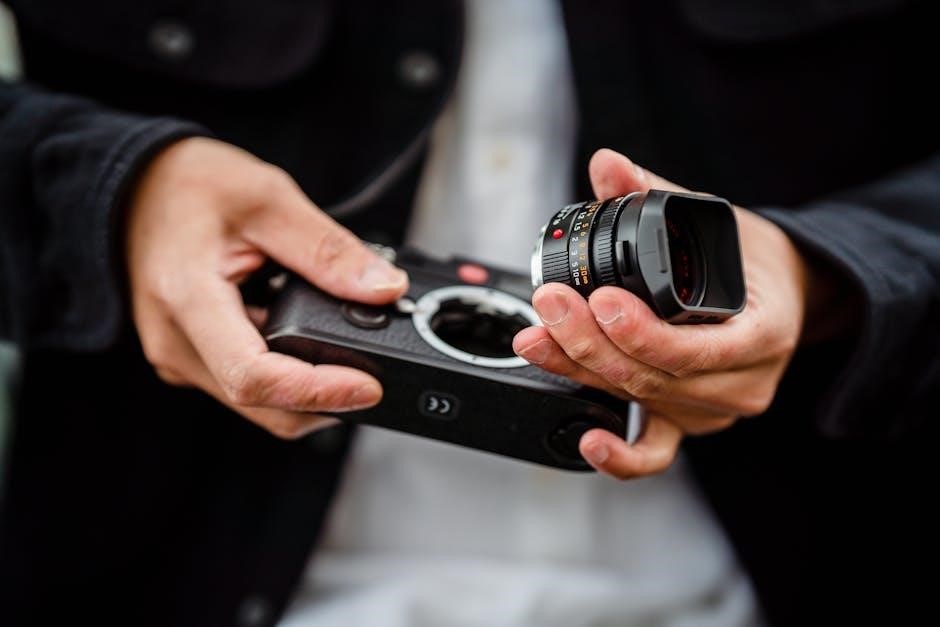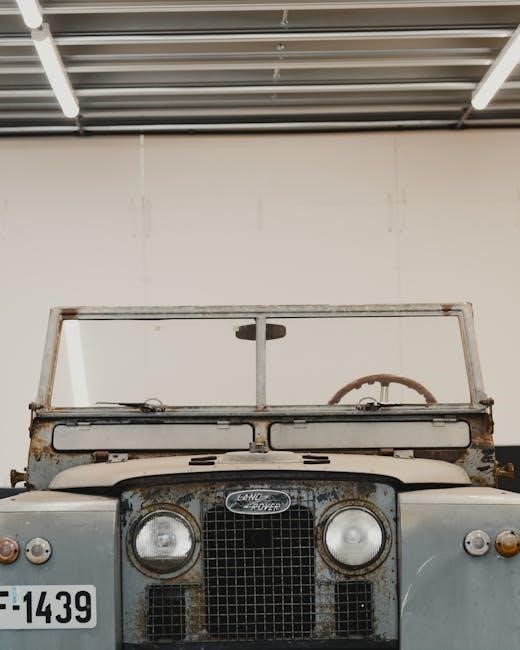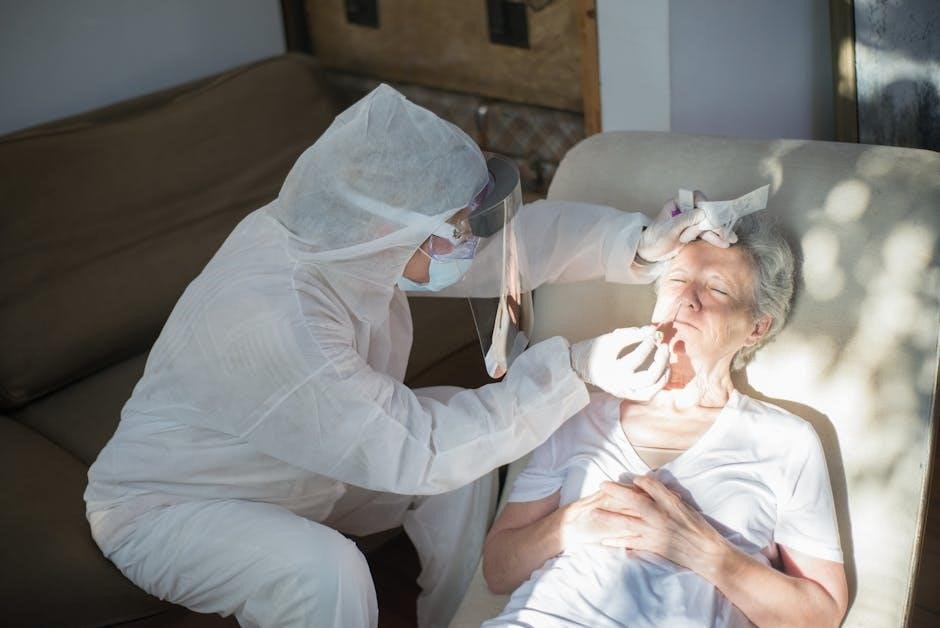Body mechanics in nursing involves the efficient use of posture, balance, and movement to prevent injuries and enhance patient care; Proper techniques are essential for safe patient handling and reducing musculoskeletal strain among healthcare workers․ Understanding body mechanics is fundamental for maintaining workplace safety and improving overall efficiency in nursing practice․
Definition and Importance of Body Mechanics
Body mechanics in nursing refers to the proper use of posture, movement, and muscle coordination to prevent injuries and enhance patient care․ It involves aligning the body correctly, using strength efficiently, and maintaining balance to minimize strain․ Proper body mechanics is crucial for preventing musculoskeletal injuries among nurses, ensuring patient safety, and improving the quality of care․ By adhering to these principles, nurses can reduce the risk of long-term health issues and maintain their ability to provide effective care․ Thus, understanding and applying body mechanics is essential for both patient well-being and the sustainability of nursing professionals in the healthcare system․
Historical Context and Evolution
Body mechanics in nursing has evolved significantly over the years, rooted in the need to prevent injuries and improve patient care․ Early practices focused on manual handling techniques, but advancements in ergonomics and occupational health led to more refined methods․ Studies from 2017 and 2019 highlighted the importance of proper body alignment and muscle coordination to reduce musculoskeletal strain․ The integration of assistive devices and team-lifting strategies marked a shift toward safer practices․ Educational programs now emphasize body mechanics as a core competency, ensuring nurses are equipped with the skills to protect themselves and their patients․ This evolution reflects a growing understanding of the critical role body mechanics plays in sustainable nursing practice and patient safety․

Principles of Proper Body Mechanics
Proper body mechanics involves maintaining optimal posture, alignment, and balance to minimize strain․ Efficient muscle activity and coordinated movement are essential for preventing injuries and enhancing patient care effectively․
Posture and Alignment

Proper posture and alignment are critical components of body mechanics in nursing․ Maintaining a neutral spine position during standing, sitting, or moving ensures optimal weight distribution and reduces strain on muscles and joints․ Nurses should keep their shoulders relaxed, chest open, and pelvis in a neutral position to avoid unnecessary tension․ When lifting or moving patients, aligning the body with the task at hand minimizes the risk of injury․ Poor posture can lead to muscle fatigue and long-term musculoskeletal disorders, making it essential for nurses to prioritize correct alignment in all caregiving activities․ Proper posture not only enhances efficiency but also supports overall workplace safety and patient care quality․
Muscle Activity and Strength Utilization
Muscle activity and strength utilization are vital in nursing body mechanics to ensure efficient and safe patient handling․ Nurses should engage core muscles and use leg strength rather than relying on back muscles, which can lead to strain․ Proper recruitment of muscle groups distributes effort evenly, reducing fatigue and injury risk․ Avoiding unnecessary twisting and bending is crucial, as these movements can overtax the musculoskeletal system․ Instead, nurses should focus on maintaining a stable base of support and using assistive devices when necessary․ By optimizing muscle activity, nurses can perform tasks more effectively while safeguarding their own well-being and providing high-quality patient care․

Balance and Coordination
Nurses must maintain balance and coordination to ensure safe patient handling and prevent falls․ Proper body alignment, with feet shoulder-width apart and knees slightly bent, provides stability․ Coordinated movements, such as shifting weight rather than twisting, reduce injury risk․ Nurses should keep their center of gravity low and use assistive devices when needed․ Good balance also allows nurses to react quickly to unexpected shifts in patient weight, preventing accidents․ Regular practice and training enhance these skills, ensuring efficient and safe care delivery while protecting both the nurse and patient from harm․ Effective balance and coordination are essential for maintaining a safe and efficient work environment in healthcare settings․
Techniques for Safe Patient Handling
Proper lifting, bending, and transferring techniques are essential for safe patient handling․ Using leg muscles, maintaining posture, and employing assistive devices minimize injury risks for both nurses and patients․
The Role of Body Mechanics in Lifting Patients
Proper body mechanics is critical when lifting patients to prevent musculoskeletal injuries and ensure patient safety․ Nurses must assess the patient’s ability to assist and maintain control during the lift․ Keeping the patient close reduces strain on the back․ Bending at the knees, keeping the back straight, and using leg muscles minimizes the risk of injury․ Distributing weight evenly and avoiding twisting is essential․ Using assistive devices, such as slide boards or mechanical lifts, further enhances safety․ Proper lifting techniques not only protect nurses but also prevent accidents that could harm patients․ Adhering to these principles ensures efficient and safe patient handling in clinical settings․
Proper Bending and Twisting Techniques
Proper bending and twisting techniques are essential to prevent musculoskeletal injuries in nursing․ When bending, nurses should maintain a neutral spine by bending at the hips and knees, avoiding rounding the back․ Twisting should be minimized, and if necessary, the feet should be pivoted to align the body with the direction of movement․ Keeping the patient or object close to the body reduces strain․ Using assistive devices, such as slide boards or mechanical lifts, can further minimize the need for harmful bending or twisting․ Proper techniques ensure both nurse and patient safety, promoting efficient and injury-free care in clinical settings․
Pushing and Pulling Strategies
Effective pushing and pulling strategies are critical in nursing to minimize strain and prevent injuries․ When pushing, nurses should stand close to the object, maintain a neutral spine, and use leg muscles to generate force․ Pulling requires a firm grip and should be done with the body positioned to avoid excessive twisting․ Keeping the load close to the body and using assistive devices, such as carts or handles, can reduce effort․ Smooth, controlled movements are essential to avoid sudden jerks that may cause harm․ Proper techniques ensure both nurse and patient safety, promoting efficient and injury-free care in clinical settings․ These strategies are vital for maintaining workplace ergonomics and reducing the risk of musculoskeletal disorders․

Risk Factors for Musculoskeletal Injuries
Repetitive tasks, poor body mechanics, and inadequate ergonomic setups are key risk factors for musculoskeletal injuries among nurses, leading to strain and long-term health issues․
Common Injuries Among Nurses
Nurses frequently experience musculoskeletal injuries due to repetitive lifting, bending, and poor body mechanics․ Back strains, shoulder injuries, and repetitive strain injuries are prevalent․ A study by A; Richardson (2019) highlights that improper lifting techniques often lead to long-term physical disabilities․ Additionally, ergonomic challenges in healthcare settings exacerbate the risk of injury․ Nurses working in emergency and intensive care units are particularly vulnerable due to high patient turnover and physically demanding tasks․ Addressing these risks requires a combination of proper training, workplace ergonomics, and the use of assistive devices․ Preventing these injuries is crucial to maintaining a healthy and effective nursing workforce․
The Impact of Poor Body Mechanics
Poor body mechanics can lead to chronic pain, musculoskeletal disorders, and long-term physical disabilities among nurses․ Improper lifting, bending, and twisting increase the risk of injuries, which can result in missed workdays and reduced job performance․ Nurses experiencing such injuries may face challenges in maintaining their career longevity․ Additionally, poor body mechanics can compromise patient safety, as injured nurses may struggle to provide optimal care․ Healthcare organizations also face increased costs due to workers’ compensation claims and staff shortages․ Addressing these issues requires a proactive approach to education and ergonomic practices to mitigate the negative consequences of improper body mechanics in nursing practice․
Workplace Ergonomics and Safety
Workplace ergonomics and safety play a crucial role in reducing the risk of injuries among nurses․ Properly designed workspaces, such as adjustable beds and equipment, can minimize strain during patient handling․ Safety protocols, including the use of assistive devices like lifts and transfer aids, are essential․ Employers should prioritize ergonomic assessments to identify and mitigate hazards․ Training programs that focus on body mechanics and safe lifting techniques can significantly lower injury rates․ A culture of safety encourages nurses to report risks and adhere to best practices, ensuring both their well-being and the quality of patient care․ Implementing these measures fosters a safer and more efficient healthcare environment․

Best Practices for Nurses
Best practices for nurses include assessing patient mobility, using assistive devices, and employing team lifting techniques․ These strategies enhance safety, reduce injury risks, and improve efficiency in patient care․
Assessing the Patient’s Weight and Mobility

Accurately assessing a patient’s weight and mobility is crucial for safe handling and effective care․ Nurses should evaluate the patient’s physical condition, including body weight, strength, and ability to move independently or with assistance․ This assessment helps determine the level of support needed and whether assistive devices or additional personnel are required․ Visual observation, patient feedback, and medical records are essential tools in this process․ Understanding the patient’s mobility limitations ensures that body mechanics are applied correctly, minimizing the risk of injury to both the patient and the nurse․ A thorough assessment also promotes personalized care plans, enhancing patient safety and overall outcomes in clinical settings․
Using Assistive Devices Effectively
Assistive devices are essential tools in nursing practice to enhance patient safety and reduce physical strain on healthcare workers․ Devices such as slide sheets, transfer belts, and mechanical lifts are designed to redistribute weight and minimize manual effort․ Proper use of these devices requires training and understanding of their specific functions․ Nurses should always select the most appropriate device based on the patient’s condition and mobility level․ Regular maintenance and inspection of equipment are crucial to ensure reliability․ Effective use of assistive devices not only prevents musculoskeletal injuries but also improves patient handling efficiency and overall care quality․ Integrating these tools into daily practice promotes a safer and more ergonomic work environment for nurses and patients alike․

Team Lifting and Communication
Team lifting and effective communication are critical components of safe patient handling in nursing․ When nurses work together to lift or move patients, they can distribute the physical effort more evenly, reducing the risk of injury to any single individual․ Clear communication ensures that all team members are coordinated and aware of their roles during the process․ Designating a leader to guide the movement and using verbal cues can enhance teamwork and patient safety․ Proper body mechanics must still be applied by each team member to avoid strain․ Regular training and practice in team lifting techniques are essential for building proficiency and confidence․ This collaborative approach not only protects nurses but also ensures patients are handled with care and dignity․

Training and Education
Comprehensive training programs integrate body mechanics into nursing education, emphasizing practical exercises and simulations to enhance skill development and injury prevention through proper techniques and practices․
Nursing Curriculum and Body Mechanics
Body mechanics is a foundational component of nursing education, integrated into curricula to equip students with essential skills for safe patient handling․ Nursing programs emphasize proper posture, movement, and strength utilization to prevent injuries․ The American Red Cross Nurse Assistant Training program, for example, includes body mechanics as a core module․ Educational materials, such as textbooks and online resources, provide detailed guidelines on lifting, bending, and transferring patients safely․ Simulation-based training is increasingly used to practice these techniques in controlled environments․ By mastering body mechanics early in their education, nurses can reduce the risk of musculoskeletal injuries and deliver high-quality, safe care throughout their careers․
Workshops and Continuing Education
Workshops and continuing education play a crucial role in refining nurses’ body mechanics skills․ These sessions often include hands-on training, allowing nurses to practice proper lifting, bending, and transferring techniques in real-life simulations․ Many programs emphasize ergonomic principles and injury prevention strategies, ensuring nurses can apply these methods in their daily practice․ Workshops also provide opportunities for peer discussion and feedback, fostering a deeper understanding of safe patient-handling practices․ Additionally, continuing education ensures nurses stay updated on the latest evidence-based techniques and technologies, further reducing the risk of musculoskeletal injuries․ Regular participation in such programs is essential for maintaining competency and promoting a culture of safety in healthcare settings․
Simulation-Based Training
Simulation-based training is an innovative approach to teaching body mechanics in nursing․ It involves interactive modules where nurses practice patient-handling skills in lifelike scenarios using advanced mannequins or virtual tools․ This method allows nurses to apply proper lifting, bending, and transferring techniques in a controlled environment, reducing the risk of injury to both themselves and patients․ Simulation training also enables healthcare educators to provide immediate feedback, helping nurses refine their skills․ By immersing nurses in real-world situations, this training enhances their ability to implement safe body mechanics consistently․ Such programs are increasingly popular in nursing education, offering a practical and engaging way to master essential techniques․

Legal and Ethical Considerations
Nurses must adhere to legal standards, avoiding liability from improper body mechanics․ Ethical duties ensure patient safety and dignity, requiring proper documentation and adherence to care standards․
Professional Standards and Liability
Professional standards in nursing require adherence to body mechanics to ensure patient safety and prevent workplace injuries․ Nurses are legally and ethically responsible for maintaining proper techniques during patient handling․ Failure to comply with established guidelines can lead to liability issues, as improper body mechanics may result in patient harm or staff injuries․ Employers and healthcare institutions are also accountable for providing adequate training and resources to support safe practices․ Proper documentation of incidents and adherence to safety protocols further mitigate liability risks․ Understanding legal implications ensures nurses practice within professional boundaries, upholding patient care quality and organizational integrity․
Patient Safety and Rights
Patient safety is a cornerstone of nursing practice, and proper body mechanics plays a crucial role in ensuring it․ By using correct lifting, transferring, and positioning techniques, nurses minimize the risk of injury to patients, promoting their well-being and dignity․ Respecting patients’ rights, including autonomy and privacy, is equally important․ Nurses must adhere to legal and ethical standards, ensuring that care is delivered safely and compassionately․ Proper body mechanics not only prevents physical harm but also upholds patients’ trust in the healthcare system․ Prioritizing patient safety and rights through effective body mechanics fosters a culture of quality care and accountability in nursing practice․
Documentation and Reporting
Accurate documentation and reporting are essential in nursing practice, particularly concerning body mechanics․ Nurses must document any incidents involving improper body mechanics that result in patient or staff injuries․ Reporting these incidents ensures that corrective actions are taken to prevent future occurrences․ Additionally, maintaining records of body mechanics training and compliance helps in assessing the effectiveness of safety protocols․ Proper documentation also serves as a legal safeguard, providing a clear account of the measures taken to ensure patient safety and staff well-being․ Timely and detailed reporting fosters transparency and accountability, contributing to a safer and more efficient healthcare environment․
Body mechanics is vital for safe patient handling and preventing nurse injuries․ Proper techniques enhance efficiency, ensuring high-quality care while safeguarding both patients and healthcare workers․
The Necessity of Body Mechanics in Nursing Practice
Body mechanics is essential in nursing to prevent musculoskeletal injuries and ensure safe patient handling․ Proper techniques reduce physical strain, promoting workplace safety and efficiency․ Nurses must master body mechanics to maintain patient care quality and protect their own well-being․ Incorrect practices can lead to injuries, impacting both nurses and patients․ Effective body mechanics enhances posture, balance, and strength utilization, minimizing risks during lifting, bending, and transferring patients․ Prioritizing these principles fosters a safer environment for everyone involved․
Future Directions and Innovations
Future advancements in body mechanics will focus on integrating technology and innovative training methods․ Wearable devices and AI-powered tools may monitor nurses’ movements, providing real-time feedback to prevent injuries․ Robotics and exoskeletons could assist in patient handling, reducing physical strain․ Simulation-based training will likely become more prevalent, offering immersive learning experiences․ Additionally, ergonomic design in healthcare settings will evolve to promote safer environments․ These innovations aim to enhance safety, efficiency, and overall well-being for nurses and patients alike, ensuring sustainable and effective nursing practices․
